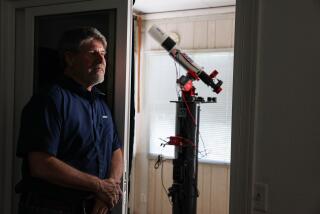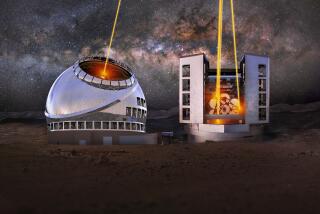TV REVIEW : ‘Astronomers’: KCET’s Profile of ‘the People’s Science’
Astronomy is perhaps the purest of all the sciences in that its singular goal is the acquisition of knowledge and understanding.
There are few spinoffs other than a greater understanding of the universe around us. It offers no guarantees of technological breakthroughs that can benefit our daily lives, or even lead to a better mousetrap. The goal of astronomy is simply to learn as much as we can about the physical universe.
Yet astronomy addresses the most fundamental questions of all: Where did we come from? How was the universe formed? How will it all end?
Those are questions of staggering and mythological importance, and they are addressed with clarity and thoroughness in “The Astronomers,” an exceptional series produced by public-television station KCET Channel 28. A $5.3-million grant from the W.M. Keck Foundation, the largest grant ever given by a foundation for a single public-TV series, provided the financial support for executive producer Blaine Baggett to send his crews to nearly every major observatory in the world.
The six-part series premieres tonight and will continue in weekly installments (8 p.m. on Channels 28 and 15, 9 p.m. on Channel 24. It will be seen Tuesdays at 8 p.m. on Channel 50).
“The Astronomers” is more than a cut-and-dried series on science, however. It follows scientists around the world as they journey to the astronomical mountain tops in search of answers to questions that it may seem arrogant to ask. How can one species on one planet orbiting an ordinary star ever hope to understand the forces and events that transpired billions of years ago? How can we ever hope to grasp the moment of creation?
The answer is through the use of tools that astronomers never even dreamed of having just a few decades ago: orbiting telescopes, giant observatories, interplanetary probes and electronic sensors.
Yet the driving force remains the same as it has always been. In tonight’s opening segment, John Dobson, who has traveled the world as a self-styled evangelist for astronomy, is shown trying to get passing citizens to look through his homemade telescope. With his scope fixed on a distant target in the starlit heavens, Dobson cries to no one in particular: “My God, everybody’s got to see this!”
As Dobson has argued for so long, astronomy is “the people’s science,” because the heavens belong to everyone. How many children have gazed across a twinkling sky and asked the same questions posed by the most brilliant scientists?
One astronomer muses that his greatest joy in life was to do as a man what he dreamed of as a boy.
Few occupations offer such a rich reward, but astronomy is also filled with the frustrations of foul weather that obscures viewing, long days and even longer nights, and questions that seem to defy answering. “The Astronomers” stays mainly on the upbeat side of the equation, concentrating on the men and women who are making history on almost a daily basis.
Astronomers are at the mercy of their subject because they cannot bring the universe into their labs and dissect it. They must merely observe it.
Yet every now and then they get a little help, as the fifth installment shows. Three years ago a star exploded in a neighboring galaxy, giving scientists the closest supernova in four centuries. That event electrified the world of astronomy because it offered a chance to observe all phases of a stellar explosion. The heavy elements that form stars and planets and even people are created in the fiery furnaces of exploding stars, so we are all made of “stardust.”
The exploding star (Supernova 1987A) compelled many scientists to reorganize their entire lives so that they could take advantage of something they may never see again.
Australian astronomer Mike Dopita dropped everything else he was working on to study Supernova 1987A, which is “radiating with the energy of 10 billion suns.”
He hasn’t found some of the answers he is seeking, but, after all, “it’s the joy of the hunt” that thrills him.
The series runs the gamut of current astronomical research. Subjects range from the search for mysterious dark matter that cannot be seen, although it is believed to make up more than 90% of the universe, to the search for other planets that might support life.
Richard Terrile of Pasadena’s Jet Propulsion Laboratory is a leader in the planetary search. He says about half the stars in the universe could have planets. If one has intelligent life, he maintains, the most important discovery in human history is waiting somewhere out there.
When it happens, it could justify a sequel to “The Astronomers.”
The science editor for the series was astronomer Donald Goldsmith. Scientific guidance was provided by a team of experts headed by Edward Stone, vice president of Caltech and director of JPL.
More to Read
The complete guide to home viewing
Get Screen Gab for everything about the TV shows and streaming movies everyone’s talking about.
You may occasionally receive promotional content from the Los Angeles Times.






